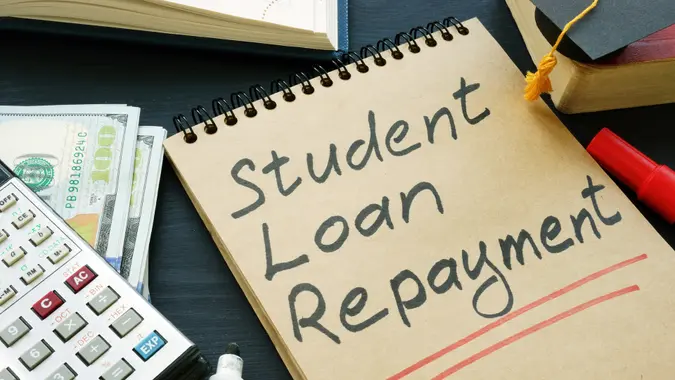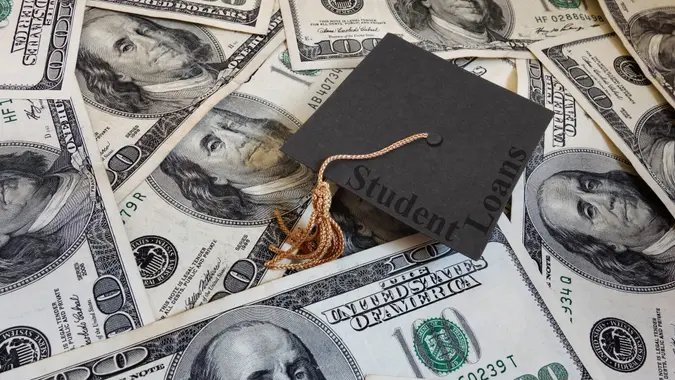How To Buy A House With Student Loan Debt

Commitment to Our Readers
GOBankingRates' editorial team is committed to bringing you unbiased reviews and information. We use data-driven methodologies to evaluate financial products and services - our reviews and ratings are not influenced by advertisers. You can read more about our editorial guidelines and our products and services review methodology.

20 Years
Helping You Live Richer

Reviewed
by Experts

Trusted by
Millions of Readers
If you want to buy a home, you might be concerned that your student loan debt will hold you back. After all, the outsized loans might be wreaking havoc on many other areas of your financial life. While extensive student loan debt may complicate the house-buying process, the good news is that it’s often possible to purchase a home with student loan debt in tow.
We explore the strategies student loan borrowers can employ to put homeownership within reach.
How Student Loans Impact Mortgage Eligibility
If you are carrying around a heavy student loan debt burden, those loans can impact your mortgage eligibility. You don’t need to be student debt-free to get a mortgage. But lenders will take all of your debts, including your student loans, into account when determining your loan eligibility.
Generally, a higher amount of student loan debt will make it more difficult to obtain a mortgage. But specifically, lenders will calculate your debt-to-income ratio. If your income is relatively high when compared to your student loan and other debt payments, then your loans might not hold you back at all. For borrowers with a high debt-to-income ratio, buying a home might be off the table until you pay down some of your debts.
Mortgage lenders want to work with borrowers who have a reliable income that’s high enough to comfortably afford a mortgage payment on top of any existing debt payments. If your monthly student loan payments are manageable, getting a mortgage shouldn’t be a problem. But if your monthly student loan obligations are out of control, then you might not find a lender willing to work with you.
How To Calculate Your Debt-To-Income Ratio
For student loan borrowers pursuing a mortgage, your debt-to-income (DTI) ratio will be a key factor. Before you dive into the mortgage search process, consider calculating your own DTI to see where you stand.
You can calculate your DTI by dividing the sum of your minimum monthly debt payments by your gross monthly income.
For example, let’s say your student loan payment is $300 per month and your personal loan payment is $100. With a gross monthly income of $5,000, your DTI would be 8%. Generally, a lower DTI is more attractive to potential mortgage lenders.
Mortgage Options for Borrowers with Student Loans
When it comes to taking out a mortgage with student loan debt, choosing the right type of loan can make or break your experience. Some mortgage loan options are more amenable to prospective homeowners with student loans. But other mortgage types have less flexibility to work with a borrower who has extensive student loans.
Below is a look at some of the mortgage options for home buyers with student loans to consider.
- Conventional loan. If you have student loan debt but have a great credit score, the 3% down payment requirement of a conventional home loan might suit your needs. But you likely won’t qualify for a conventional loan if your DTI ratio is above 50%.
- FHA loans. The Federal Housing Administration backs the FHA Loan and comes with higher DTI limits. Depending on your situation, you might be able to get an FHA loan with a DTI ratio as high as 57%.
- VA loans. Prospective homeowners with sufficient military experience or an eligible connection may qualify for a VA loan, which is backed by the Department of Veterans Affairs. Depending on your situation, you might be able to buy a home with a DTI ratio of up to 60%.
- First-time home buyer programs. Some first-time homebuyer programs are designed to help potential homeowners with large debt burdens achieve the goal of homeownership through special down payment assistance options or reduced interest rates. Determine if your state or local government offers one of these programs in your area to move your homeownership quest forward.
If your DTI ratio is too high to qualify for a mortgage on your own, consider purchasing a home with a co-borrower. Since a lender assesses the combined financial situation of you and your co-borrower, you might improve your approval odds. For example, if your co-borrower has minimal debts and a high income, that could lead to the necessary DTI ratio for your combined application to be approved.
Student Loan Repayment Strategies for Prospective Homeowners
If you want to buy a house and your student loan obligations are holding you back, consider tapping into one of the following student loan repayment strategies to boost your chances of landing a home loan.
- Income-drive repayment plans. If you have federal student loans, signing up for an income-driven repayment plan could lower your monthly payments. With a lower monthly payment obligation, your debt-to-income ratio might look at bit more attractive to a potential lender.
- Refinance your student loans. Refinancing your student loans could help you obtain a lower interest rate or lower monthly payment, both of which could help your financial situation when applying for a mortgage loan. Before refinancing federal student loans, review the federal borrower protections you would give up by refinancing to a private student loan. In some cases, refinancing isn’t worth the cost of giving up these protections, like loan forgiveness programs.
How to Save for a Down Payment with Student Loans
It’s possible to purchase a home and put down as little as 3%. Even though that’s less than the often-cited 20%, it can still be a significant amount of money to save up for most. For example, putting 3% down on a $300,000 home purchase would add up to $9,000. Plus, you’ll still have closing costs to cover.
If you want to avoid paying private mortgage insurance (PMI), you’ll need to put down at least 20%. That’s often a significant number for savers. For example, putting 20% down on a $300,000 home would require $60,000. Below are some strategies to save up for a down payment while managing student loans.
- Automate your savings. Take a look at your budget and determine how much you want to set aside for your future home purchase each month. Set up an automatic transfer directly from your checking account to a dedicated savings account each month.
- Cut down on expenses. You might have to make cuts to your discretionary spending to make room for savings. For example, you might need to eliminate eating out, subscription memberships, get a roommate, and more to dial in your savings.
- Grow a new income stream. Finding a side hustle like selling crafts or renting out your vehicle could help you build your home down payment fund quickly.
Remember, you can lower the amount you need for a down payment by shopping for a more affordable home. Consider lowering your home purchase budget to match the size of the down payment you can build within your timeline.
How To Pay Off Your Debt
Paying off your student loans or another debt ahead of schedule offers one way to lower your DTI ratio and improve your chances of getting a mortgage approval. Below are some strategies to help you get out of debt faster:
- Sell stuff. If you have clutter around the house, consider selling those items online or through a garage sale for cash. You can put the proceeds toward your debt.
- Increase your income. Asking for a raise at work or landing a higher-paying job will lower your DTI ratio. Plus, you can use the extra money to streamline your debt repayment.
- Pick up a side hustle. Most lenders want to see consistent income for two years before counting a side hustle into your mortgage numbers. But you can use the newfound funds to pay down some of your debts.
Eliminating a single monthly payment, like a credit card bill, from your life, should lower your DTI ratio. As you knock down your monthly payment obligations, you’ll free up the financial bandwidth to tackle a mortgage.
Final Take
Buying a home with student loans is possible. For those with manageable student loans, the debt shouldn’t hold you back at all. For borrowers with crippling student loan debt, you may need to make headway on paying down your loans and lowering your DTI ratio before you can move forward with a home purchase.
More From GOBankingRates
 Written by
Written by  Edited by
Edited by 
























